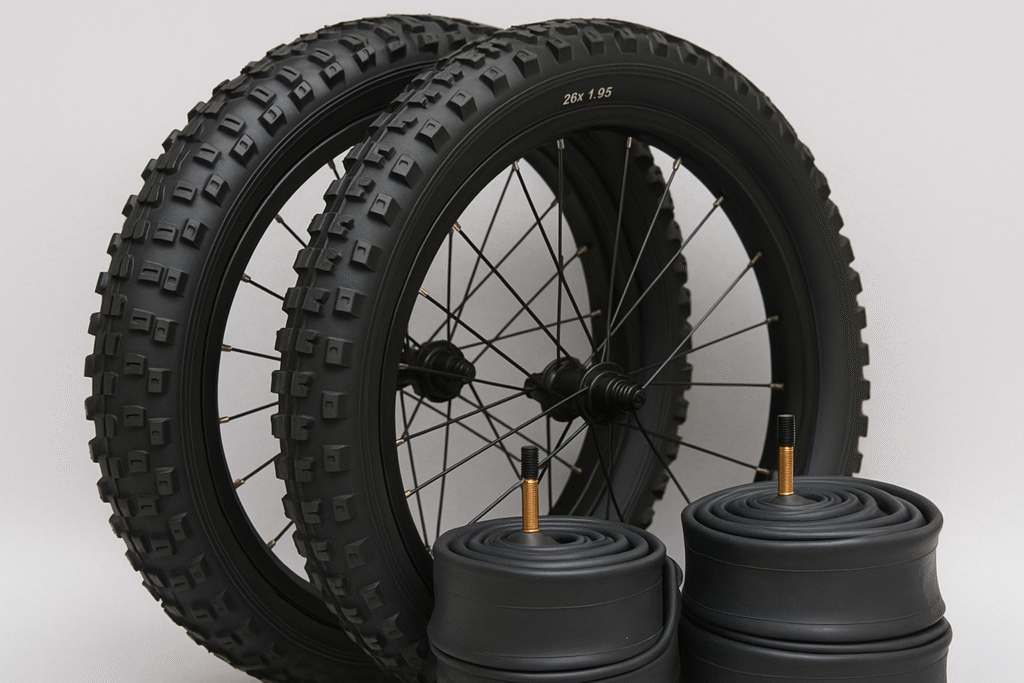
1. Introduction
Choosing the right 26-inch bicycle tires and tubes 26 inch setup is essential for performance, comfort, and reliability. Whether you’re a casual rider, commuter, or off-road cyclist, understanding the differences between tube and tubeless systems can help you make an informed decision. From flat protection to rolling efficiency, each option offers unique benefits. This guide breaks down key factors—including tire types, repair kits, installation tips, and cost considerations—to help you select the best fit for your riding style and terrain.
Table of Contents
2. Understanding 26 Inch Bicycle Tires and Tubes
The 26-inch bicycle tire is a long-standing standard commonly found on mountain bikes, hybrids, and some older commuter bikes. These tires offer a balance between stability, comfort, and off-road capability, making them ideal for recreational riders and trail cyclists alike.
A 26-inch tire refers to the outer diameter of the tire, but the width and tire type (clincher, tubeless, etc.) can vary. It’s essential to match the tube size correctly with both the tire diameter and width—for example, a 26 x 1.95 tire will require a tube compatible with that width range.
Some 26-inch tires come pre-installed with tubes, while others are tubeless-ready, offering lower rolling resistance and fewer pinch flats. Selecting between tubed and tubeless tires comes down to how you ride and how much maintenance you’re willing to manage.
Understanding your specific bike’s compatibility with bicycle tires and tubes 26 inch is crucial for optimal performance, safety, and ease of repair—especially when transitioning from standard tubes to tubeless setups.
3. Tube vs. Tubeless: What’s Best for 26-Inch Tires?
When choosing between tubed and tubeless systems for 26-inch bicycle tires, the decision depends on your riding conditions, maintenance preferences, and performance needs.
Tires with inner tubes are the traditional setup, commonly found on older or budget-friendly 26-inch bikes. They’re easy to install, widely available, and simple to repair. However, they’re more prone to pinch flats, especially on rough terrain or under low tire pressure.
Tubeless tires attach directly to the rim without requiring an inner tube. When used with a sealant, they provide enhanced puncture resistance, superior grip, and reduced rolling resistance. A tubeless tire repair kit, such as the KOM Cycling Tubeless Tire Repair Kit, can quickly fix punctures on the trail without needing a tube.
For casual riders or urban commuting, traditional tubes may suffice. However, if you prioritize performance, trail efficiency, or want fewer flats, tubeless is often the better choice for 26-inch tires.
4. Recommended Tire & Tube Combinations (Including 20-Inch)
When selecting tire and tube combinations for your bicycle, compatibility and riding purpose are key. For 26-inch bicycle tires and tubes, pairing standard clincher tires with matching inner tubes remains the most common setup for recreational and commuter use. Choose a durable tire with puncture-resistant layers and a butyl rubber tube for reliable everyday performance.
For smaller bikes, such as folding bikes or kids’ bikes, 20-inch tires and tubes are popular. Ensure the tube size precisely matches the tire’s width and diameter—most 20-inch tires work best with tubes marked 20 x 1.75–2.125.
Riders seeking fewer flats and better off-road traction may prefer tubeless tire setups. These eliminate the need for an inner tube and, when combined with sealant, offer a self-sealing system ideal for rough trails or long-distance riding.
No matter the size, always confirm valve compatibility (Presta or Schrader) and select a quality brand for both tire and tube. Trusted combinations like Schwalbe Marathon Plus tires with matching inner tubes or tubeless setups from Maxxis or Continental are solid choices for performance and reliability.
5. Tubeless Tire Repair Kits: Must-Haves for Road and MTB Riders
For riders using tubeless setups, carrying a tubeless tire repair kit is essential. Whether you’re on smooth tarmac or rugged trails, even the best tubeless tires can suffer punctures too large for sealant alone to fix. A reliable kit allows quick, on-the-go repairs without removing the tire.
Most tubeless repair kits for road bikes and mountain bikes (MTB) include rubber plugs (also called bacon strips), an insertion tool, and sometimes a small reamer or valve core tool. Compact options like the KOM Cycling Tubeless Tire Repair Kit are ideal for cyclists looking to save space while ensuring preparedness.
The best tubeless tire repair kits are lightweight, durable, and compatible with both 26-inch and 20-inch tire setups. Some high-end kits include CO₂ cartridges for instant inflation, while others are designed to integrate with bike frames or saddlebags for easy access.
When riding tubeless, don’t leave home without a proper repair kit—it can mean the difference between finishing your ride or walking it home.
6. Installation Tips: How to Replace a Tube or Repair Tubeless
Replacing a bike tube or repairing a tubeless setup requires basic tools and a methodical approach. For tubed tires, start by removing the wheel, deflating the tire completely, and using tire levers to unseat one side. Pull out the damaged tube, check the tire for sharp objects, then insert a new tube. Inflate partially to position it correctly, seat the tire back on, and fully inflate.
For tubeless tires, ensure the tire bead is unseated on one side. Clean the rim and inspect for damage. If sealant has dried up, clean it out. Add fresh tubeless sealant, reseat the tire bead, and inflate using a tubeless-compatible pump or air compressor to ensure a proper seal.
When dealing with large punctures, use a tubeless repair kit with plugs to fill the hole. Always check that the seal holds before continuing your ride.
These installation and repair steps help maintain the performance and safety of your 26-inch or 20-inch bicycle tires and tubes, whether you’re using traditional tubes or a tubeless system.
7. Cost Breakdown: Tubes, Tires, and Repair Expenses
Understanding the costs involved in maintaining bicycle tires and tubes (26 inch and 20 inch) helps riders budget more effectively. On average:
- Standard inner tubes for 26-inch or 20-inch bikes cost between $5 to $15 each, depending on the brand and valve type.
- Bicycle tires range from $20 to $60 for mid-range models, while premium or tubeless-ready tires can exceed $80.
- Tubeless tire repair kits—such as the KOM Cycling Tubeless Tire Repair Kit—typically cost $10 to $30, offering long-term value by preventing the need for tube replacements.
- Professional tube replacement services can add $10 to $20 in labor, while car tire tube replacement costs are higher and not directly applicable to bicycles but sometimes used as a comparison.
Choosing quality parts and learning basic repairs can significantly reduce long-term expenses while ensuring a smoother, safer ride.
8. Conclusion
Whether you’re riding with 26-inch bicycle tires, 20-inch tubes, or exploring the benefits of tubeless setups, understanding your tire and tube options is essential for performance, comfort, and safety. From choosing between tube vs. tubeless tires to learning how to repair and maintain them efficiently, being informed helps reduce downtime and repair costs. Prioritizing the right tire and tube combinations, knowing when to replace or patch, and keeping essential repair tools on hand will enhance your overall cycling experience. Choose based on your terrain, riding style, and maintenance preferences to get the most out of every ride.
9. FAQs
Q1. Do 26-inch bike tires come with tubes?
Most 26-inch bike tires sold individually do not include inner tubes. Tubes must usually be purchased separately unless specified as part of a combo package.
Q2. Can I use a 26-inch tubeless tire on a standard rim?
Only if the rim is tubeless-compatible. Standard rims may not provide an airtight seal, so upgrading to tubeless-ready rims is recommended for optimal performance and safety.
Q3. What’s better for road biking: tube or tubeless?
Tubeless tires offer lower rolling resistance, fewer flats, and better grip—making them a strong choice for road biking. However, they require precise installation and ongoing sealant maintenance.
Q4. Is there a difference between 26-inch and 20-inch bike tubes?
Yes, tube sizes must match the tire size. Always verify tube size before purchase.
Q5. How much does it cost to replace a bicycle tire tube?
On average, tube replacement costs range from $5–$15 for the part and $10–$25 for labor at a shop.
Q6. What tools are needed to repair a tubeless tire?
Essential items include a tubeless tire repair kit, tire plugs, an insertion tool, and sealant. Popular kits like the KOM Cycling Tubeless Tire Repair Kit are compact and road/MTB friendly.
Q7. Can I convert my 26-inch tube tire setup to tubeless?
Absolutely. By using a tubeless conversion kit along with tubeless-ready rims and compatible tires, you can make the switch. A correct installation guarantees a secure seal and enhances overall ride quality.
